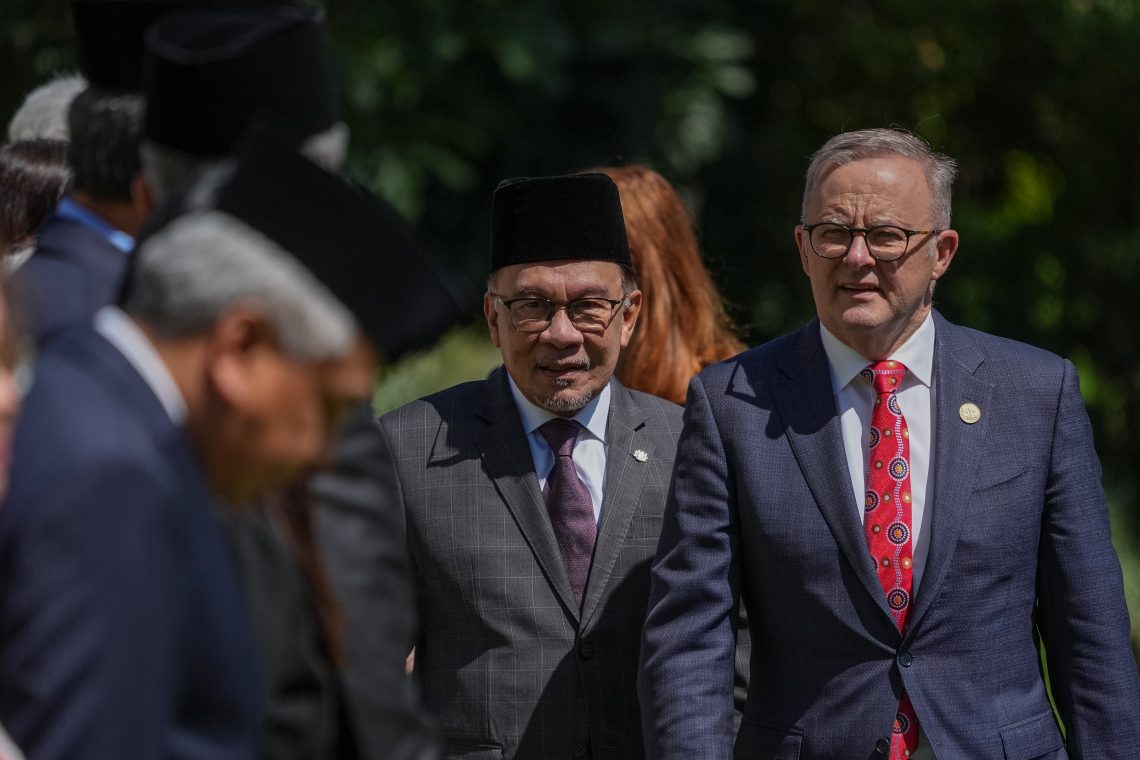Malaysia’s leader sets an active foreign policy vision despite headwinds
Prime Minister Anwar believes the country has been punching below its weight internationally and needs bold, pro-growth reform at home.

In a nutshell
- Malaysia set to wield tools to boost its economy and international standing
- Prime Minister Anwar’s experienced political hand gives him an edge
- Instability at home and abroad are hurdles for his Madani framework
Prime Minister Anwar Ibrahim is calculating that he can boost Malaysia’s economic prospects and international sway by correcting the years of perceived drift the country experienced under his predecessors. Since he came to office in November 2022, Kuala Lumpur has been pursuing a more active foreign policy approach while promoting domestic reforms. Mr. Anwar has signaled that the country’s diplomatic role could also become more important, as it builds up ties with neighbors within the Association of Southeast Asian Nations (ASEAN) amid intensifying major power competition and grows more vocal on flashpoints such as the Myanmar civil war and the Israel-Gaza conflict.
The prime minister’s goals are ambitious and derived from his reputation as a well-connected, globally-minded thinker dating back to government positions in the 1980s and 1990s before he was sacked, jailed and then entered opposition politics. His Madani framework – a recipe to promote good governance and investment, foster innovation and enable domestic industries to expand globally – is being paired with efforts to elevate Malaysia into the world’s top 30 economies within 10 years. Mr. Anwar aims to attract foreign direct investment, push the leading sectors up the value chain, and accelerate the growth rate by up to 6 percent.
Economically, this may be feasible. In January 2024, S&P said it viewed the ASEAN region positively, thanks to dynamic growth, rising domestic demand and inward investments driven by multinationals diversifying supply chains toward Southeast Asia. That feeds into the optimism about ASEAN’s growth trajectory, with the region poised to be the fourth-largest global economy by 2030. Malaysia also recently reported the highest-ever rate of foreign investments entering the country, even though that news was eclipsed by the fact that the Malaysian currency, the ringgit, had fallen to its lowest level since the 1997 Asian financial crisis.
The country then experienced two short-lived cabinets and prolonged instability before Prime Minister Anwar came to power in late 2022.
Yet how Malaysia will manage a confluence of crises regionally and globally is an open question. The memories of domestic political turmoil in recent years make for a wary Malaysian public with limited patience for reforms. A critical question, then, is what must Mr. Anwar overcome to steer the country through multiple external challenges and its own fragile political stability?
The uphill push
Malaysia has experienced much turbulence in recent years. In May 2018, the opposition removed the then-ruling coalition from power for the first time in the nation’s history, after the multi-billion-dollar looting of the country’s sovereign wealth fund known as the 1MDB scandal. The next government was ousted through political maneuvering in 2020. The country then experienced two short-lived cabinets and prolonged instability before Prime Minister Anwar came to power in late 2022. During that time, the challenges faced by Malaysia had significantly grown amid the Covid-19 pandemic and the intensifying United States-China competition.
Facts & figures
Malaysia basic facts
Malaysia straddles parts of the Malay Peninsula and the island of Borneo. It gained independence from the United Kingdom in 1957. The Federation of Malaysia was formed following the merger of the Federation of Malaya, Singapore, North Borneo (Sabah) and Sarawak in 1963, and Singapore separated from it in 1965. Malaysia currently consists of 13 states and three federal territories.
- Total area: 330,803 sq. km (127,724 sq. miles)
- Population: 34.3 million (2023), nearly 80% concentrated in peninsular Malaysia
- Religions: Muslim (official) 63.5%, Buddhist 18.7%, Christian 9.1%, Hindu 6.1%, others and unspecified 3.7% (2020)
- Political system: federal constitutional monarchy
- Natural resources: tin, petroleum, timber, copper, iron ore, natural gas, bauxite
- Economy: upper-middle income; exporter of electronics, oil, and chemicals; over 40% of jobs are in the trade sector
- Labor force: 17.3 million (2022)
- GDP: $431 billion (nominal); $1.3 trillion (PPP) (2023)
- GDP per capita (PPP): $33,525 (2023)
- GDP growth rate: 3.7% (2023)
- Main trade partners: ASEAN, China, the U.S., the EU and Japan accounted for 67.7% of Malaysia’s total trade in 2023; China’s share alone was 17.1%
- World Bank ease of doing business rating: 12th place among 190 world economies
- Military expenditure: about 1% of GDP (2024)
Sources: The World Bank, CIA World Factbook, Malaysia Central Bank
As in recent years, Mr. Anwar’s government faces challenges. Sharp, connected and experienced as the prime minister may be, he and his advisors know that they cannot advance their activist foreign policy by delivering rousing speeches and amassing diplomatic travel miles alone. Enhancing Malaysia’s role as a credible middle power also requires wisely expending limited political capital and strengthening the country’s security, diplomatic resources and networks.
Those are time-consuming activities, and the clock is ticking on Mr. Anwar’s window of opportunity to deliver. At home, his popularity ratings have dipped, and anger has risen among some voters over economic concerns. Political compromises made under his leadership, such as the shortening of the prison term for former Prime Minister Najib Razak (2009-2018) who was implicated during the 1MDB scandal, have soured the public mood.
Read more on Southeast Asia
- Thailand’s foreign policy vision collides with reality
- Indonesia’s foreign policy after the 2024 presidential elections
- AUKUS raises temperature in Southeast Asia
Abroad, while many foreign companies have welcomed Malaysia’s improving political stability and the clarity of the Madani framework, there are concerns about the sustainability of reforms and the country’s ability to address longer-term challenges. Prime Minister Anwar and his team recognize this uphill task. For instance, the trade minister candidly admitted there are lingering questions about how Kuala Lumpur can address structural problems such as insufficient human capital skills. There are also ongoing conversations about how to streamline bureaucratic processes and produce clear and regularly-evaluated performance benchmarks to power change.
An important test for Prime Minister Anwar and his team will come in 2025 when Malaysia will hold the annually rotating chairmanship of ASEAN. How Kuala Lumpur handles this opportunity will spotlight its ability to perform at demanding international fora and demonstrate the reach of its influence.
Scenarios
Looking ahead, three scenarios for Malaysia’s efforts to shore up its international standing are possible.
Most likely: A gradually increased regional role
Under this scenario, the Anwar government would make incremental progress in select areas despite confronting a daunting set of challenges at home and abroad. Malaysia’s regional and international image would grow amid progress with its immediate neighbors, such as cross-border economic cooperation with Singapore and connectivity and tourism with Thailand.
Malaysia will also seek to leverage its chairmanship of ASEAN in 2025 and the ASEAN-China dialogue partner coordinator role from 2024 to 2027 to showcase its role in Southeast Asian community-building and its agency on critical issues, such as U.S.-China competition. In this light, Kuala Lumpur will explore deepening its economic links with leading powers like Japan and the U.S. to balance out its growing ties with China – its top economic partner. Such expansion could manifest in priority sectors outlined in the government’s strategic plans, such as semiconductors and electric vehicle production.
Less likely: A snapback scenario
In this scenario, Malaysia would revert to a less active foreign policy approach amid protracted domestic instability. That could happen if the current coalition government fractures or shifting political dynamics weaken Prime Minister Anwar’s hold on power.
Malaysia would retain some of its new visibility, for example when it comes to its economic sectors of strength such as electronics or within diplomatic fora in Southeast Asia and parts of the Global South, where Mr. Anwar’s straight-talking approach to foreign policy will be appreciated. However, the country’s list of foreign policy priorities would be narrowed to those critical for the ruling regime’s staying power.
This scenario could see more transactional initiatives prioritizing short-term regime goals over the country’s longer-term strategic interests, such as quick economic deals with China. It would also not fully address the structural issues that the government has identified as inhibiting the country’s economic potential.
As a result, Malaysia would continue to grow at a modest rate and opportunistically benefit from some supply chain shifts from China. However, it would fall well short of achieving Prime Minister Anwar’s goal of becoming an ASEAN economic powerhouse.
Least likely: Reinventing Malaysia
This scenario sees the prime minister’s active policy vision taking shape quicker and more comprehensively than the selective, incremental manner described in the first scenario.
Given the complexity of domestic matters and the challenges that lie ahead for the country, few expect such a scenario to materialize. However, it should not be ruled out. Mr. Anwar was part of the earlier reformist government (2018-2020) that set forth plans for the structural shifts needed to improve the country’s foreign policy and defense outlooks.
These changes included substantive issues, such as paying closer attention to technological disruption, anti-corruption, inclusive politics and post-conflict assistance. They also laid out a plan to boost the government’s resources, empower the foreign ministry, improve inter-governmental coordination and increase civil society participation. Even partial progress on some of the aforementioned steps in the coming years would help improve Malaysia’s international standing.
For industry-specific scenarios and bespoke geopolitical intelligence, contact us and we will provide you with more information about our advisory services.








